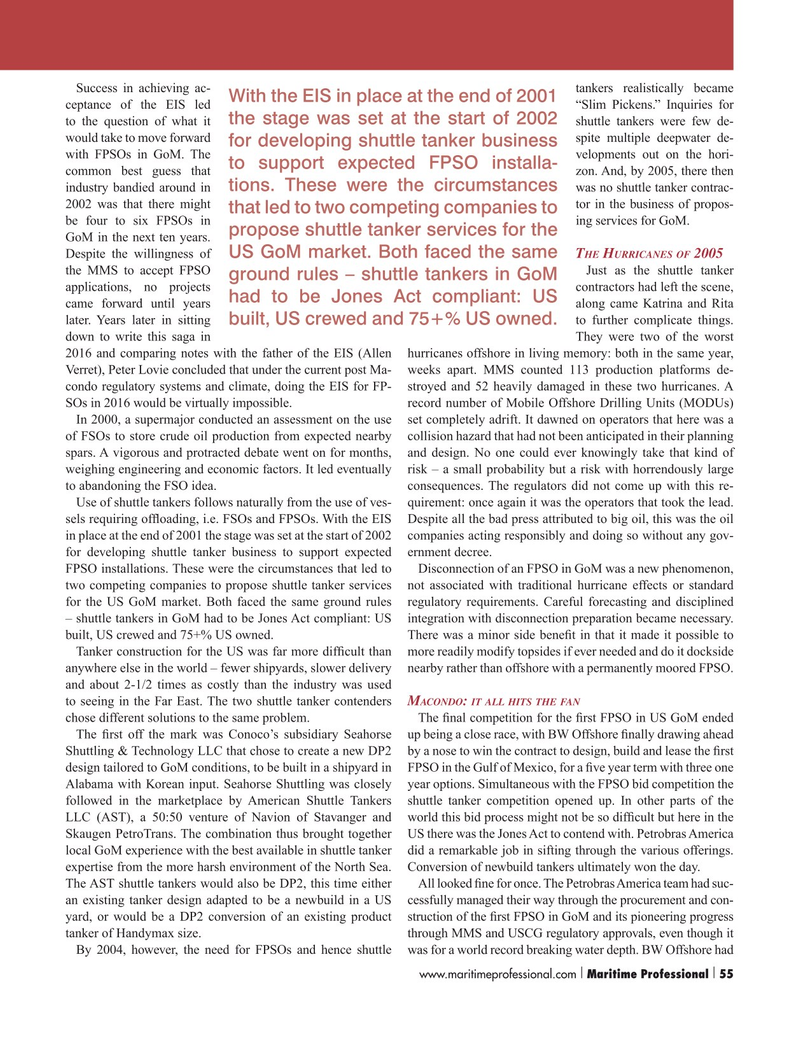
Page 55: of Maritime Logistics Professional Magazine (Q2 2016)
Energy Transport & Support
Read this page in Pdf, Flash or Html5 edition of Q2 2016 Maritime Logistics Professional Magazine
Success in achieving ac- tankers realistically became
With the EIS in place at the end of 2001 ceptance of the EIS led “Slim Pickens.” Inquiries for the stage was set at the start of 2002 to the question of what it shuttle tankers were few de- would take to move forward spite multiple deepwater de- for developing shuttle tanker business with FPSOs in GoM. The velopments out on the hori- to support expected FPSO installa- common best guess that zon. And, by 2005, there then tions. These were the circumstances industry bandied around in was no shuttle tanker contrac- 2002 was that there might tor in the business of propos- that led to two competing companies to be four to six FPSOs in ing services for GoM.
propose shuttle tanker services for the
GoM in the next ten years.
Despite the willingness of T H 2005HE URRICANES OF
US GoM market. Both faced the same the MMS to accept FPSO Just as the shuttle tanker ground rules – shuttle tankers in GoM applications, no projects contractors had left the scene, had to be Jones Act compliant: US came forward until years along came Katrina and Rita later. Years later in sitting to further complicate things. built, US crewed and 75+% US owned.
down to write this saga in They were two of the worst 2016 and comparing notes with the father of the EIS (Allen hurricanes offshore in living memory: both in the same year,
Verret), Peter Lovie concluded that under the current post Ma- weeks apart. MMS counted 113 production platforms de- condo regulatory systems and climate, doing the EIS for FP- stroyed and 52 heavily damaged in these two hurricanes. A
SOs in 2016 would be virtually impossible. record number of Mobile Offshore Drilling Units (MODUs)
In 2000, a supermajor conducted an assessment on the use set completely adrift. It dawned on operators that here was a of FSOs to store crude oil production from expected nearby collision hazard that had not been anticipated in their planning spars. A vigorous and protracted debate went on for months, and design. No one could ever knowingly take that kind of weighing engineering and economic factors. It led eventually risk – a small probability but a risk with horrendously large to abandoning the FSO idea. consequences. The regulators did not come up with this re-
Use of shuttle tankers follows naturally from the use of ves- quirement: once again it was the operators that took the lead. sels requiring of? oading, i.e. FSOs and FPSOs. With the EIS Despite all the bad press attributed to big oil, this was the oil in place at the end of 2001 the stage was set at the start of 2002 companies acting responsibly and doing so without any gov- for developing shuttle tanker business to support expected ernment decree.
FPSO installations. These were the circumstances that led to Disconnection of an FPSO in GoM was a new phenomenon, two competing companies to propose shuttle tanker services not associated with traditional hurricane effects or standard for the US GoM market. Both faced the same ground rules regulatory requirements. Careful forecasting and disciplined – shuttle tankers in GoM had to be Jones Act compliant: US integration with disconnection preparation became necessary. built, US crewed and 75+% US owned. There was a minor side bene? t in that it made it possible to
Tanker construction for the US was far more dif? cult than more readily modify topsides if ever needed and do it dockside anywhere else in the world – fewer shipyards, slower delivery nearby rather than offshore with a permanently moored FPSO.
and about 2-1/2 times as costly than the industry was used to seeing in the Far East. The two shuttle tanker contenders M : ACONDO IT ALL HITS THE FAN chose different solutions to the same problem. The ? nal competition for the ? rst FPSO in US GoM ended
The ? rst off the mark was Conoco’s subsidiary Seahorse up being a close race, with BW Offshore ? nally drawing ahead
Shuttling & Technology LLC that chose to create a new DP2 by a nose to win the contract to design, build and lease the ? rst design tailored to GoM conditions, to be built in a shipyard in FPSO in the Gulf of Mexico, for a ? ve year term with three one
Alabama with Korean input. Seahorse Shuttling was closely year options. Simultaneous with the FPSO bid competition the followed in the marketplace by American Shuttle Tankers shuttle tanker competition opened up. In other parts of the
LLC (AST), a 50:50 venture of Navion of Stavanger and world this bid process might not be so dif? cult but here in the
Skaugen PetroTrans. The combination thus brought together US there was the Jones Act to contend with. Petrobras America local GoM experience with the best available in shuttle tanker did a remarkable job in sifting through the various offerings. expertise from the more harsh environment of the North Sea. Conversion of newbuild tankers ultimately won the day.
The AST shuttle tankers would also be DP2, this time either All looked ? ne for once. The Petrobras America team had suc- an existing tanker design adapted to be a newbuild in a US cessfully managed their way through the procurement and con- yard, or would be a DP2 conversion of an existing product struction of the ? rst FPSO in GoM and its pioneering progress tanker of Handymax size. through MMS and USCG regulatory approvals, even though it
By 2004, however, the need for FPSOs and hence shuttle was for a world record breaking water depth. BW Offshore had www.maritimeprofessional.com Maritime Professional 55| | 50-63 Q2 MP2016.indd 55 5/19/2016 11:47:54 AM

 54
54

 56
56
